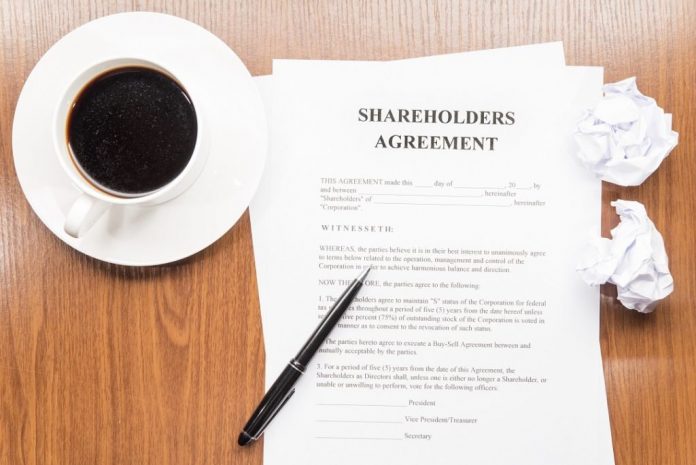This article is written by Saroj Chauhan, pursuing a Diploma in Advanced Contract Drafting, Negotiation, and Dispute Resolution from LawSikho.
Table of Contents
Introduction
Managing a successful business needs quick decisions, careful balancing of competing priorities, and meticulous organisational planning. Organisational planning, while sometimes disregarded – especially as a business grows quickly – is the glue that holds the company together no matter what. By-laws, articles, corporate legislations make the organisation of companies smoother. In that context, it is important to understand one’s rights and responsibilities as a shareholder as it is critical to maintaining the company’s long-term viability and success. There may be times when shareholders wish to agree on things that are outside the scope of the corporation’s legislation and operating documents. Shareholders will be able to do this thanks to the unanimous shareholder agreement, which is an agreement in which shareholders specify their obligations to one another and help govern shareholder behaviour in certain circumstances.
A unanimous shareholder agreement (“USA”) is a shareholder agreement that:
- is signed by all shareholders when it is first signed;
- binds future shareholders regardless of whether they sign; and
- removes, in whole or in part, the duties and powers of the corporation’s directors to the extent that shareholders assume them.
A unanimous shareholder agreement (“USA”) is intended to limit or revoke the powers of a corporation’s board of directors in whole or in part. A USA is much more than a contract; it permits shareholders to deviate from the corporate governance standards that apply to business corporations. Through this article, the author seeks to understand the ‘Unanimous Shareholder Agreement’, the advantages and disadvantages that it poses, and the effect of having a USA on both majority and minority shareholders.
Advantages of a unanimous shareholder agreement
The fundamental benefit of a USA is that it usually incorporates provisions in two areas: decision-making and share transfers, which are especially useful in the event of deadlocks or an unexpected transition in share ownership as a result of, say, a shareholder’s insolvency or death.
When there are two or more shareholders in a closely held corporation, a USA is normally preferred. The process of forming a USA can also be quite advantageous, especially during the early phases of the company’s formation, because it establishes expectations and creates provisions that will ideally prevent future lengthy, expensive, and sometimes devastating disagreements.
Why adopt a unanimous shareholder agreement?
Shareholders face certain risks as a result of their ownership of a corporation’s stock; a USA can help to mitigate and manage these risks. In addition to various other factors, if a corporation has a majority shareholder, it may be beneficial to minority shareholders to negotiate a USA. A minority shareholder spending significant capital, for example, may seek specific safeguards from the majority or significant shareholder. A USA could be a valuable measure for averting future shareholder disputes. If a dispute arises, a USA might be able to significantly minimise the expenses of the dispute.
Important provisions or clauses to be incorporated while drafting a unanimous shareholder agreement
Governance, management, and control provisions
The governance section of such an agreement will include provisions for the board of directors and its committees, as well as shareholder approval of specific actions. A USA may enforce specific rules for the appointment of the board of directors, as well as the removal of individual members from the board. A minority shareholder, for example, may want to know that if she invests, will she be guaranteed a seat on the board of directors. She can ask all stockholders in a USA to agree to this. Shareholders in a USA can negotiate for additional safeguards such as requiring a supermajority or unanimous vote on some crucial matters or expanding the list of actions that require shareholder consent.
Restricted powers
To begin with, shareholders in the USA have the ability to limit the powers of the directors. Such a restriction can take many forms, and it may or may not need the shareholders’ indirect engagement in the corporation’s management. One way is to change the majority-vote rule for the board’s adoption of decisions. This can be accomplished by increasing the required number of votes, demanding a special majority, or establishing a veto privilege. Another option is to require shareholder approval before board decisions are made. Despite its popularity, many people prefer to avoid the latter technique since its two-step decision-making procedure has the potential to drastically slow down decision-making.
Sample : A, B, and C are the owners of XYZ Corporation. A controls 80% of the voting shares, whereas B and C each control 10%. A, B, and C make up the board of directors. To prevent B and C from being able to make all corporate choices at the expense of A, some significant business decisions may be subject to A’s concurring vote. As a result, A retains authority over such decisions while allowing minority shareholders to participate in the corporation’s day-to-day management.
Withdrawal of powers
The option to relieve directors of their duties permits shareholders to take on some or all of the powers that the board of directors would normally have. This has the advantage of allowing shareholders to not only exercise direct control over the corporation’s affairs but also to commit in advance to how they would vote on decisions made under these new powers, something that directors are unable to do. However, it should be noted that reducing directors’ powers carries risk because once a USA takes effect, the shareholders will be responsible for the directors’ responsibilities and liabilities.
Sample: The option to relieve directors of their duties permits shareholders to take on some or all of the powers that the board of directors would normally have. This has the advantage of allowing shareholders to not only exercise direct control over the corporation’s affairs but also to commit in advance to how they would vote on decisions made under these new powers, something that directors are unable to do. However, it should be noted that reducing directors’ powers carries risk because once a USA takes effect, the shareholders will be responsible for the directors’ responsibilities and liabilities.
Share transfer
Most USAs require that share transfers be conditional on the receiver being a party to the USA as a general rule. The following clauses may also be included in this rule:
Right of first refusal
Existing shareholders must first match a bona fide offer from a third party to purchase a shareholder’s shares, which could prevent a third-party purchaser from becoming a shareholder if it is determined that it is not in the company’s best interests.
Shotgun provision
This clause comes in handy if the relationship between shareholders deteriorates and one party wishes to leave. It enables a shareholder to determine the terms and price at which he or she is willing to sell or purchase shares from another shareholder. The other shareholders decide whether to acquire the given shares or sell their own based on the terms and conditions presented, depending on the scenario.
Piggyback or tag along provision
This clause permits additional shareholders to include their shares in the agreement with the third-party buyer if a shareholder desires (and is able) to sell their shares to a third-party buyer. This allows those extra owners to “tag along” and leave the organisation.
Sample clauses
Restrictions on transfer
- No Shareholder may transfer any of his or her Shares unless and until the Articles and this Agreement expressly enable it (the “Permitted Transferee”). Any attempted Transfer of Shares that is made in violation of this agreement is invalid. Any Transfer of Shares made in violation of this agreement will not be approved or ratified by the board of directors or the shareholders, and the corporation will not allow any such transfer to be registered on the corporation’s share register for the shares.
- All rights of the Shareholder purporting to make the Transfer shall be suspended and inoperative from and after the date of the attempted transfer, unless otherwise expressly provided in this agreement, and no person shall be entitled to vote such Shares or receive dividends or other distributions until the Transfer is rescinded by the transferor and transferee.
- Any transfer of shares to a permitted transferee is contingent on the shareholder entering into and agreeing to be bound by the terms of the shareholder agreement contained herein, or such alternative shareholder agreement as the parties may mutually agree.
Confidentiality
This provision protects stockholders from illegal disclosures of confidential information. It’s especially important when the shareholders are also critical company employees with access to sensitive information.
Non-compete and non-solicit
For a set period of time, these rules limit the capacity of shareholders to compete with the firm or to recruit staff away from it. Depending on their level of involvement with the organisation, these provisions may apply to shareholders in different ways. As previously said, key personnel will very certainly be subjected to more stringent rules.
Dispute resolution
These clauses establish channels for settling a variety of disagreements. The numerous processes may include a unilateral choice by one of the parties, negotiation, mediation, arbitration, and buy-sell/shot-gun clauses, depending on the disagreement in question. A buy-sell/shot-gun clause is an offer made by one shareholder to another to purchase all of the shares of the other shareholder for a set price.
In each situation, the decision must be made after a thorough debate among the shareholders, and it will be based on their unique demands and circumstances. Declaring and paying dividends, issuing shares, appointing officials, and making decisions outside of the normal course of business are some of the more prominent examples.
It should be remembered that for the USA to be legal, it must be signed by all shareholders, regardless of whether or not their shares contain voting rights. The USA shall bind all future shareholders, providing they are informed of its existence, in addition to these signing shareholders. Any shareholder or creditor of the corporation shall be able to consult a copy of the USA, which must be retained as part of the corporate records.
Finally, unless otherwise specified in the merger agreement, a USA expires immediately if the corporation becomes a reporting issuer under the Securities Act or if the business merges pursuant to a long-form amalgamation.
While the conclusion of a USA may appear straightforward at first glance, there are other crucial factors to consider. As a result, we advise that you get legal advice before signing one.
Conclusion
The conditions of a USA are determined by the parties’ individual needs and must be adjusted to handle their specific risks and objectives. A USA should plan for future events that are reasonably anticipated to occur, as well as offer flexibility for dealing with unforeseen circumstances. The structure and membership of the board, the division of management between the board and shareholders and among shareholders, exit rights and other limits on share sales, and the conditions of any existing governing instruments will all need to be considered and negotiated at the outset. While negotiating a USA can be difficult, it is typically easier to negotiate equitable provisions for foreseen concerns before an event occurs than it is to do so after the fact.
References
- https://www.mondaq.com/canada/shareholders/359370/the-unanimous-shareholder-agreement-more-than-just-a-difference-in-terminology
- https://www.mondaq.com/canada/shareholders/501134/a-brief-introduction-to-unanimous-shareholder-agreements
- https://www.chamberplan.ca/product/blogs/read,article/12/an-introduction-to-unanimous-shareholder-agreements
- https://www.chamberplan.ca/product/blogs/read,article/12/an-introduction-to-unanimous-shareholder-agreements
- https://www.bdplaw.com/content/uploads/2016/06/Shareholders-Agreements.pdf
- file:///F:/Downloads/Documents/Sample-Shareholders-Agreement.pdf
- https://www.sec.gov/Archives/edgar/data/1561660/000156166018000102/exhibit101.htm
Students of LawSikho courses regularly produce writing assignments and work on practical exercises as a part of their coursework and develop themselves in real-life practical skills.
LawSikho has created a telegram group for exchanging legal knowledge, referrals, and various opportunities. You can click on this link and join:
 Serato DJ Crack 2025Serato DJ PRO Crack
Serato DJ Crack 2025Serato DJ PRO Crack










 Allow notifications
Allow notifications



